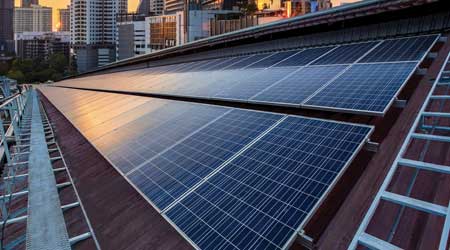What Does Portfolio Manager Data Say About the Rise of Renewables?
A new analysis of Energy Star data for on-site renewable energy show huge growth in adoption in commercial facilities.
A recent report analyzing EPA Energy Star's Portfolio Manager database for use of on-site renewable energy generation found adoption grew ten-fold since 2009, now involving nearly 1 percent of all buildings in Portfolio Manager. Of the 263,865 properties using Portfolio Manager, 2,447 are currently generating on-site renewable energy. This number is made up mostly of retail stores (553 properties), K-12 schools (491 properties), and office buildings (405 properties), with multifamily housing, warehouse, and public services facilities also contributing over 100 properties each. As a percentage of their building type, K-12 schools and worship facilities had the highest adoption rate, at 2.4 percent.
In the Portfolio Manager cohort, none of the facilities are supplying all of their electricity needs with onsite renewable. The warehouse market is able to meet 51 percent of its need, and retail 36 percent. The majority of property types meet about a quarter of their need with on-site renewable generation.
On-site renewable generation in Portfolio Manager is most commonly found in California, with the lion's share of properties at 981. The next top three areas are Colorado, New York, and New Jersey. EPA's report posits this could be driven by population density, as well as supportive state-level policies.
While Portfolio Manager does provide a rich dataset, it is not currently possible to extrapolate from the Portfolio Manager data what is occurring regarding on-site renewable generation in the larger population. One aspect that is potentially hampering the reporting of on-site generation is the absence of smart meters in the market, which make it simpler to segregate use and generation data.
"Going forward the deployment of smart meters will be critical to ensure the accurate measurements of building efficiency," says Lauren Hodges, director of communications, Energy Star for Commercial Buildings & Industrial Plants. "Without these meters that are capable of measuring flows both into and out of a building separately, and then reporting those flows to the customer, a building is not able to get an accurate picture of their energy performance."
There are other options for trying to get at the missing data, such as third-party energy management systems or non-billing systems within the utility, but it's a bit of a process. Facility managers considering new on-site renewable generation would do well to ask their wind or solar developer or utility for smart meters, Hodges says.
Related Topics:














